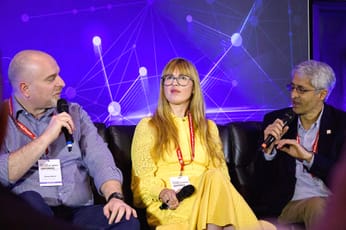#newsrw - What's the best social media strategy for media companies?
Suw Charman-Anderson still chairing, with a rod of iron…
Jack Riley, The Independent

He’s going to talk about the best ways of bring about institutional change (and I’m feeing my scars itching as he says it). The Independent has open graph pages for Facebook, majority of journalists tweeting, and designed the site to allow users to share the content. “On and of the social web” – you have to think about how you exist within the community.
The basics are tools. Everyone’s seen the Like button, but you can do things to optimise the site. They have higher than average referrals from social media:
Like buttons: Near headlines, faces, top and bottom of stories.
Turn each piece of content into an object that exists on the social web. Open graph: six or seven lines of code that tells Facebook what the content is. 23,000 people have Liked Robert Fisk on Facebook, and because it’s configured right, they can push content back to Facebook. The feedback rate is three times higher on these sorts of Likes, as people are self-selecting. They’ve done the same with Football teams. Acknowledge niche interest in social contexts.
There’s been a move towards using non-propriety. The move to Disqus increased comments five fold, while increasing accountability.
Trove – an experimental news aggregation site, that’s based on a Facebook login.
Personalised URLs – The community share more content than we do. The Indy gets more clicks per link, but there are so many more users…
Declarative or interrogative headlines? Questions encourage a conversation rather than declarative statements.
It’s important to have a social mindset within the staff. We do live Q&As which we then repupose and push back into print.
Mark Jones, Reuters

The company is constitutionally bound to explore new technologies. They’ve had a lot of success with aggregation blogs during key events – but people tend to love it when it’s going, but get annoyed when it finishes.
Journalists in a chat room engaging busy professionals makes them money…
Journalists aren’t always skilled in being hosts and creating conversations. Hence, 25 full time community managers. They’re working with Tweetminster to figure out ways of analysing the conversation between bloggers and tweeters and figure out useful information for particuclar people, like venture capitalists – peHUB.
Their comfort zone is working with people they know, and now they’re expanding into working with people they don’t…
Mark Johnston, community editor, the Economist – @majohns

Not just Twitter and Facebook, but also the social media site under his nose – economist.com
The idea of competitive debate is inherent to everything they do. They strongly believe that reader-contributed content can make the site better. They have an extremely distinguished, knowledgeable and intelligent audience. Community contributors view six times more pages than the average visitor. A proper social media strategy is an important way of dragging visitors from first time to regular visitors to coming to events to becoming editor…
1.1m followers on Twitter, 700k on Facebook. But the important trend is the increasing levels of traffic from these social media sites.
Ask the Economist – monthly live web chat on Twitter, but integrated on Economist.com.
The Economist Debates – two years old now. As many comments on Facebook as on the site now, but seeking to integrate them more.
By Invitation Panel – 50 economists who are fans of the Economist. They send a single question, and they provide their responses.
Ideas Arena
Figure out what is special about your brand, and then figure out how to make that work in a social environment.
Stefan Stern – Edelmann
Mindset shifts needed from people who have built their careers in traditional forms. Journalists have treated readers like some teachers do parents – that they should mind their own business and stay out of the process.

Handled properly, social media is a liferaft for journalists in the era of citizen journalists. Stern is queasy about free as a business model. But it also makes you a social being, one who creates and finds interesting material.
He’s become more active on Twitter since leaving the FT – and his number of followers has increased. He’s freer to speak out at Edelmann than at the FT…
“Strategy” and media companies have not always been comfortable bedfellows, but it’s becoming necessary in a time of change.
Suw Charman-Anderson

How do you get to a social media strategy in the first place?
Suw & Kevin went to work with Network18 in Mumbai. It was an opportunity to shape a strategy from scratch, social and digital-first. First question: who were they speaking to? Concept: original content plus aggregation. How do you aggregate? Not just reading RSS feeds – the journalists need to be embedded in their beats socially. And that means figuring out what the audience are already doing in social media. They decided to take the audeince on a journey from shallow social media usage to something more interactive.
Also, peaks and troughs of use. Peak of mobile in the morning (good time to tweet) – peak at lunchtime, when people had time for in-depth – good time for blogging. Production? Whole suite of tools we could use – which support our strategy? May launch from a Feb start – 1/9/90 rule. 1% will seriously engage, 9% will engage somewhat and 90% will lurk. What actions will they engage with? You can’t just bolt social media on the side, you have to integrate it with your product.
Q&A
Stern: moving from era when journalists were authorities handing down wisdom from on high, to an era when the ability to engage boost your career. Evidence will convert over time.
Jones: you need to treat the internal editorial network. Work with the keenest and big them up internally. The chief executive repeatedly saying that it’s important helps.
A general discussion about which is better for traffic – Facebook or Twitter. Charman-Anderson points out that its horses for courses – different audiences use different social media sites (including LinkedIn)
Sign up for e-mail updates
Join the newsletter to receive the latest posts in your inbox.








